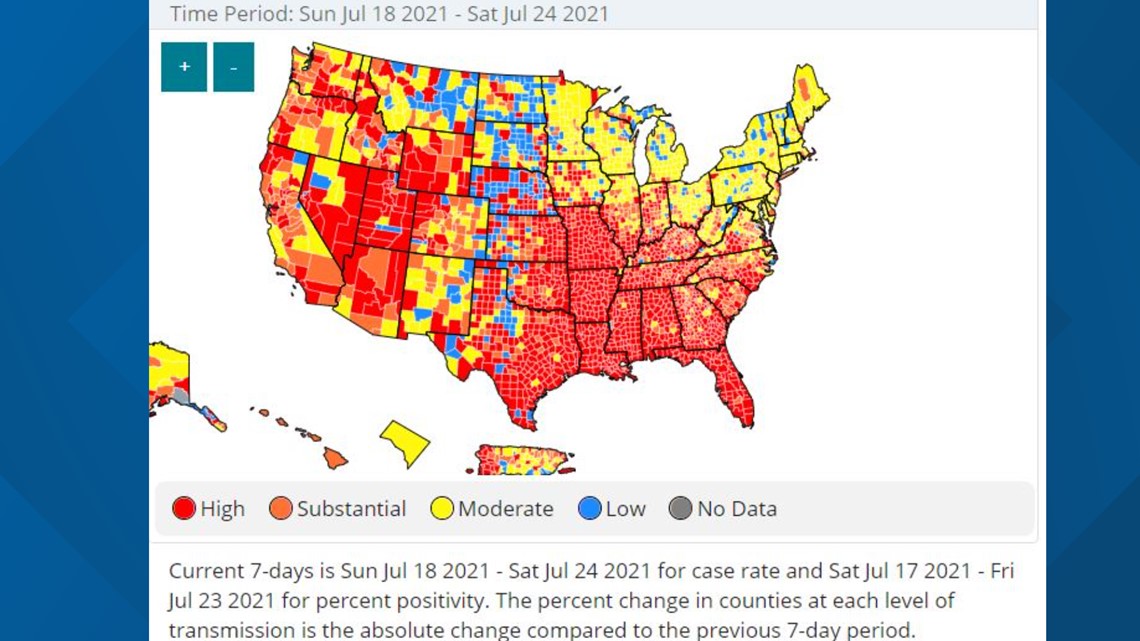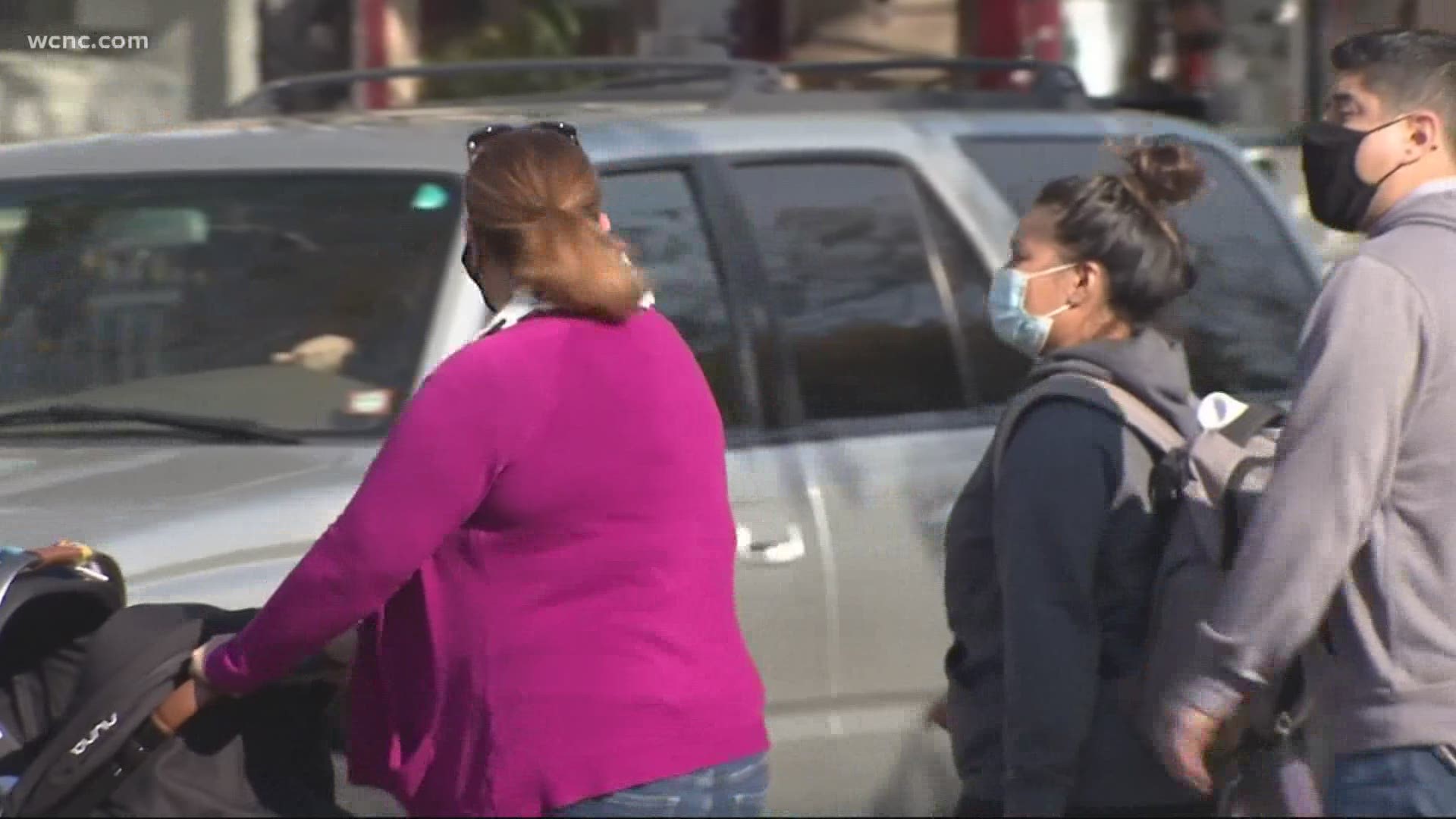WASHINGTON — The Centers for Disease Control and Prevention changed course Tuesday on some masking guidelines, recommending that even vaccinated people return to wearing masks indoors in parts of the U.S. where the delta variant of the coronavirus is fueling infection surges.
Citing new information about the variant's ability to spread among vaccinated people, the CDC also recommended indoor masks for all teachers, staff, students and visitors at schools nationwide, regardless of vaccination status.
In other developments, President Joe Biden said his administration was considering requiring all federal workers to get vaccinated. His comments came a day after the Department of Veterans Affairs became the first federal agency to require its health care workers receive the vaccine.
The new mask guidance follows recent decisions in Los Angeles and St. Louis to revert to indoor mask mandates amid a spike in COVID-19 cases and hospitalizations that have been especially bad in the South. The country is averaging more than 57,000 cases a day and 24,000 COVID-19 hospitalizations.
The guidance on masks in indoor public places applies in parts of the country with at least 50 new cases per 100,000 people in the last week. That includes 60 percent of U.S. counties, officials said.
The CDC said to look at its county-by-county online data tracker to see where COVID-19 is surging. In the color-coded map, orange reflects substantial community transmission and red indicates high transmission.


Most new infections in the U.S. continue to be among unvaccinated people. So-called breakthrough infections, which generally cause milder illness, can occur in vaccinated people. When earlier strains of the virus predominated, infected vaccinated people were found to have low levels of virus and were deemed unlikely to spread the virus much, CDC Director Dr. Rochelle Walensky said.
But with the delta variant, the level of virus in infected vaccinated people is "indistinguishable” from the level of virus in the noses and throats of unvaccinated people, Walensky said.
The data emerged over the last couple of days from over 100 samples from several states and one other country. It is unpublished, and the CDC has not released it. But “it is concerning enough that we feel like we have to act,” Walensky said.
Vaccinated people "have the potential to spread that virus to others,” she said.
For much of the pandemic, the CDC advised Americans to wear masks outdoors if they were within 6 feet of one another.
Then in April, as vaccination rates rose sharply, the agency eased its guidelines on the wearing of masks outdoors, saying that fully vaccinated Americans no longer needed to cover their faces unless they were in a big crowd of strangers. In May, the guidance was eased further for fully vaccinated people, allowing them to stop wearing masks outdoors in crowds and in most indoor settings.
The guidance still called for wearing masks in crowded indoor settings, like buses, planes, hospitals, prisons and homeless shelters, but it cleared the way for reopening workplaces and other venues.
Subsequent CDC guidance said fully vaccinated people no longer needed to wear masks at schools either.


For months COVID cases, deaths and hospitalizations were falling steadily, but those trends began to change at the beginning of the summer as the delta variant, a mutated and more transmissible version of the virus, began to spread widely, especially in areas with lower vaccination rates.
White House press secretary Jen Psaki said the delta variant has changed the nation’s COVID-19 outlook since the the CDC relaxed masking recommendations.
“That is their job. Their job is to look at evolving information, evolving data, an evolving historic pandemic and provide guidance to the American public,” Psaki said.
“What has not changed,” she added, “is the fact that people who are vaccinated have a huge deal of protection from serious illness, from hospitalization and from death.”
Some public health experts said they thought the earlier CDC decision was based on good science. But those experts were also critical, noting that there was no call for Americans to document their vaccination status, which created an honor system. Unvaccinated people who did not want to wear masks in the first place saw it as an opportunity to do what they wanted, they said.
“If all the unvaccinated people were responsible and wore mask indoors, we would not be seeing this surge,” said Dr. Ali Khan, a former CDC disease investigator who now is dean of the University of Nebraska’s College of Public Health.
Lawrence Gostin, a public health law professor at Georgetown University, drew a similar conclusion.
“It was completely foreseeable that when they (the CDC) made their announcement, masking would no longer be the norm, and that’s exactly what’s happened,” Gostin said.
The CDC may be seen as “flip-flopping,” he said, because there’s been no widely recognized change in the science, he said. Furthermore, it’s not likely to change the behavior of the people who most need to wear masks.
“I don’t think you can effectively walk that back,” he said.
Walensky said she is aware of the criticisms and concerns, and she acknowledged that many Americans are weary of the pandemic and do not want to return to prevention measures. But she said new scientific information forced the decision to change the guidance again.
“This is not something that I took lightly,” she said.
Ken Thigpen, a retired respiratory therapist who now works for a medical device manufacturer, is fully vaccinated and stopped wearing his mask in public after the CDC changed its guidance in May. But he started to reconsider in the last week after his job took him to hospitals in Mississippi, Louisiana, Alabama and Florida, where he witnessed medical centers getting inundated with COVID-19 patients.
“That delta variant is intense. It is so transmissible that we have to do something to tamp it down,” he said.
“I loved it when I could call the hospitals and they said, ‘We actually closed our COVID ward today or we are down to two COVID patients,’" he recalled. "And now we are opening the wards back up, and the numbers are going nuts.”
President Biden statement on updated CDC mask
When I ran for President, I promised to be straight with you about COVID—good news or bad. And I promised to follow the science. That strategy has worked: in my first six months in office, we’ve given out over 300 million shots—and have 60% of adults fully vaccinated and nearly 70% started on vaccinations. Cases are down, and deaths are down dramatically. One estimate suggests that our rapid deployment of the vaccine has saved 100,000 American lives—perhaps more.
Today’s announcement by the CDC—that new research and concerns about the Delta variant leads CDC to recommend a return to masking in parts of the country—is another step on our journey to defeating this virus. I hope all Americans who live in the areas covered by the CDC guidance will follow it; I certainly will when I travel to these areas.
Today, the CDC also reaffirmed that we can safely reopen schools this fall—full time. Masking students is inconvenient, I know, but will allow them to learn and be with their classmates with the best available protection.
Most importantly, today’s announcement also makes clear that the most important protection we have against the Delta variant is to get vaccinated. Although most U.S. adults are vaccinated, too many are not. While we have seen an increase in vaccinations in recent days, we still need to do better.
On Thursday, I will lay out the next steps in our effort to get more Americans vaccinated. Vaccinations are free, safe, and effective to every American. They’ve been available to every adult in this country for more than three months—at locations within 5 miles of 90% of the US population.
By following the science, and by doing our part by getting vaccinated, America can beat COVID. In the meantime, more vaccinations and mask wearing in the areas most impacted by the Delta variant will enable us to avoid the kind of lockdowns, shutdowns, school closures, and disruptions we faced in 2020. Unlike 2020, we have both the scientific knowledge and the tools to prevent the spread of this disease. We are not going back to that.

